10 Best Probiotic Superfoods for Gut Health [Plus Recipes!]
40 Best DIY Gift Ideas for Any Occasion
50 Gorgeous Handcrafted Wreaths on Etsy
10 Festive Christmas Simmer Pot Recipes
40 Dollar Store DIY Fall DÉcor Ideas
40 Easy Rotisserie Chicken Shortcut Meals
60 Christmas Cookies for Every Taste
Gift Guides for Everyone on Your List
55 Best Harry Potter Party Hacks
Make the most of fall and the holiday season with our best décor ideas, recipes, gift ideas & more.
SEe What's Trending
Learn More ›
Clean everything in your home from your clothes and sheets to your shower curtain, vents - even the inside of your washing machine - with simple short-cuts using all-natural cleaning products.
Available in paperback and
Kindle. editions.
Get the cleaning hacks book
Natural Cleaning
Home DÉcor
Christmas
Thanksgiving
Halloween
Fall
Recipes
Top Categories
More About Me ›
Hi, I'm Sarah! I share all the best recipes, lifestyle tips, décor ideas & more to help you live your best life, naturally. Come for meal ideas and life hacks, and stay for updates and community.
sarah blooms!
welcome to
Gift Guides
Try these 10 Best Probiotic Superfoods for Gut Health to promote optimal health, energy, improved digestion, and weight loss!
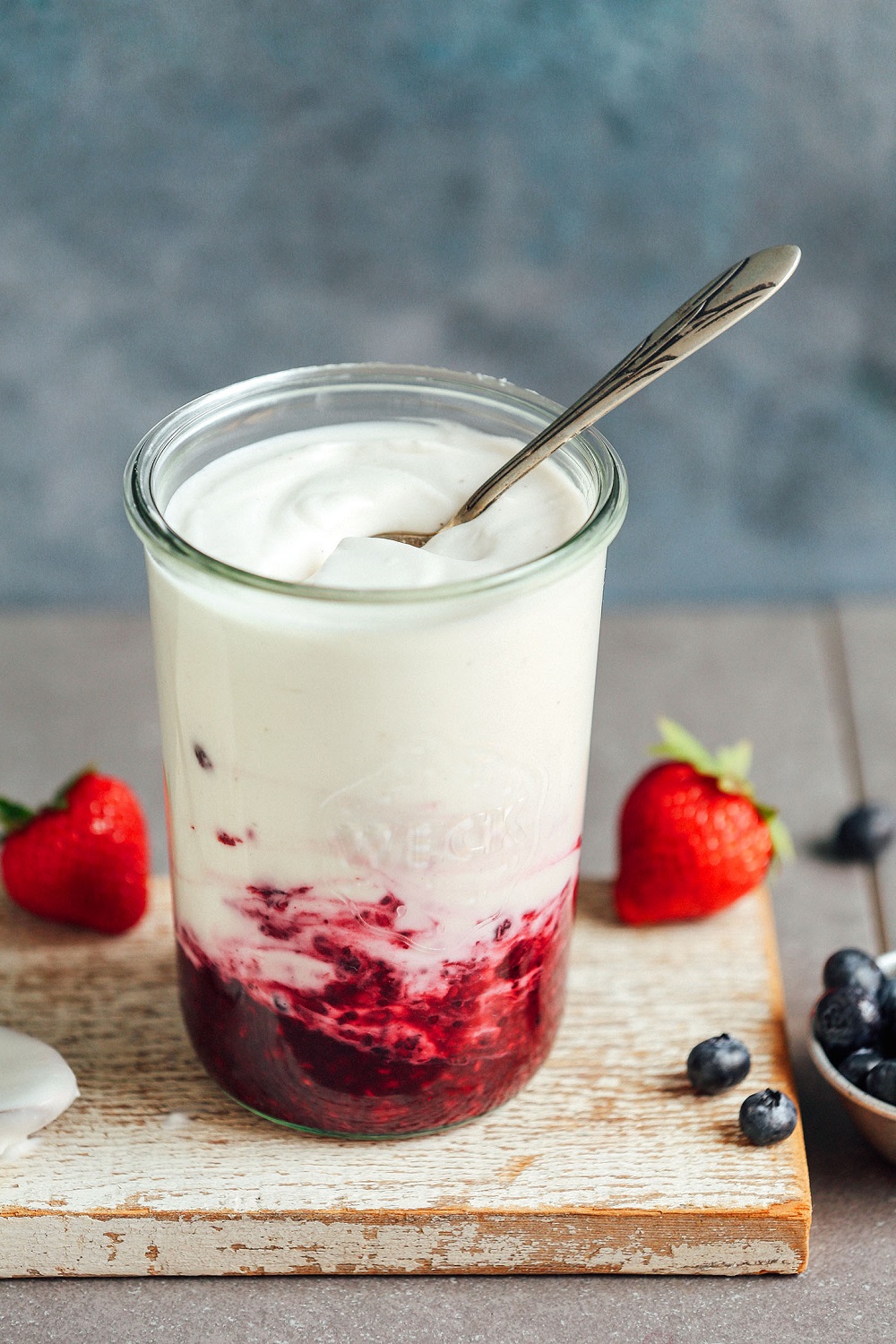
For centuries before freezers and canned goods were invented, humans made fermented foods to help preserve vegetables and keep them edible longer, but fermentation isn’t only great for preserving food.
Fermented foods are making a comeback because they’ve been found to enhance the overall nutritional value of food, have immense benefits on gut health and immunity, and may even promote weight loss!
Your gut (and entire body) naturally contains both harmful, disease-causing bacteria and beneficial bacteria.
It’s okay to have “bad bacteria,” but it’s incredibly important to keep the right balance of good and bad bacteria in your gut and body for optimal health.
One of the best ways to eliminate excess bad bacteria and increase good bacteria is to eat and drink fermented foods and beverages loaded with probiotics.
Probiotics are “good bacteria” that promote wellness and gut health.
Most people have a probiotic deficiency, which can lead to leaky gut and a host of other health problems.
Keep reading to learn all about the Best Probiotic Superfoods for Gut Health complete with easy recipes to help you get started with this amazing health craze that promotes optimal health, energy, vitality, and weight loss!
PRO TIP: If you’re new to fermented foods, start with 1/2 cup per day, and build up from there to avoid any digestive issues.
While these foods are super healthy, consuming a lot all at once when your body’s not used to them may cause diarrhea, gas, bloating, and other minor digestive issues.
For the best health benefits, try to consume probiotic rich foods every day, or at least most days.
For more healthy living tips, check out the following:
10 Delicious, Gut Healing Probiotic Drinks You Can Make at Home
20 Easy Ways to Boost Your Metabolism [That are Backed by Science]
30 Best Weight Loss Foods You Need to Keep in Your Kitchen
30 Easy Ways to Eat Healthy on a Budget
Pin for Later!
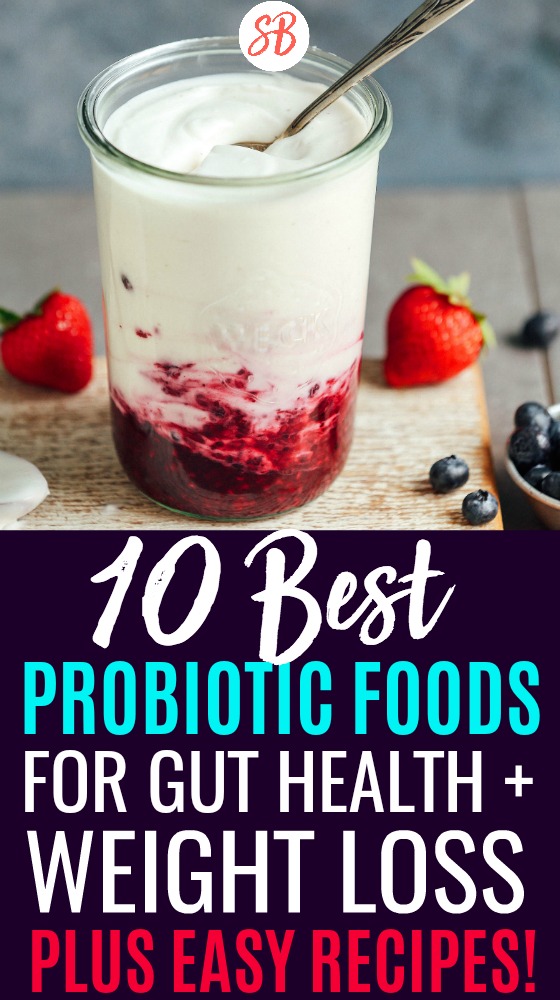
Fermentation 101
When foods are fermented, they go through a process called lacto-fermentation, wherein natural bacteria feeds on the sugar and starch in these foods and creates lactic acid.
These nutrients produced by the fermentation process help aid digestion, support your immune system, and may even help you lose weight.
Studies suggest that consuming these foods may also improve mood, skin health, and can alleviate the symptoms of (and even heal!) a host of health problems, including autoimmune diseases and IBS.
Fermented foods are easy to fit into your diet, but some of these foods are more beneficial than others.
For instance, sauerkraut and pickles bought in grocery stores are not usually fermented.
Instead, they are soaked in vinegar, salt, and other flavorings for that sour taste we love, but this process does not produce the probiotics we need for good health.
Also, any fermented foods that have been pasteurized, such as sauerkraut, pickles, and vinegar, also won’t provide the great health benefits of raw, probiotic rich fermented foods.
Be sure to read the label when you buy anything pre-packaged to ensure the foods you eat contain these healthy nutrients.
regular grocery stores
Most grocery stores are finally realizing that consumers want more healthy foods, and many are responding by stocking their shelves with probiotic rich choices!
I live in a small town, and even my local grocery stores carry kombucha, kefir, both dairy and non-dairy yogurts, tempeh, kimchi, and raw, unpasteurized apple cider vinegar, which is usually the only type of fermented vinegar offered in grocery stores and most health food stores.
health food stores
Any good-quality health food store should stock plenty of kombucha,, kefir (or at least kits to make these drinks), tempeh, raw sauerkraut, kimchi, yogurt, raw cheese, and maybe more!
Feel free to ask for help at your local health food store.
They should be able to show you their selection of probiotic foods and may even get more kinds in stock if you show interest.
Best Probiotic Superfoods for Optimal Health and Immunity
dill pickles
Dill pickles are a fantastic diet food because they’re low in calories and aren’t loaded with sugar like bread and butter pickles.
They’re also a great source of Vitamin K – one pickle contains about 18% of your daily value! – so you can alleviate this common vitamin deficiency just by eating pickles regularly!
Improve those health benefits even more by making your own crunchy pickles containing gut healthy probiotics, much less salt than store bought, and zero preservatives with this easy and delicious dill pickle recipe.
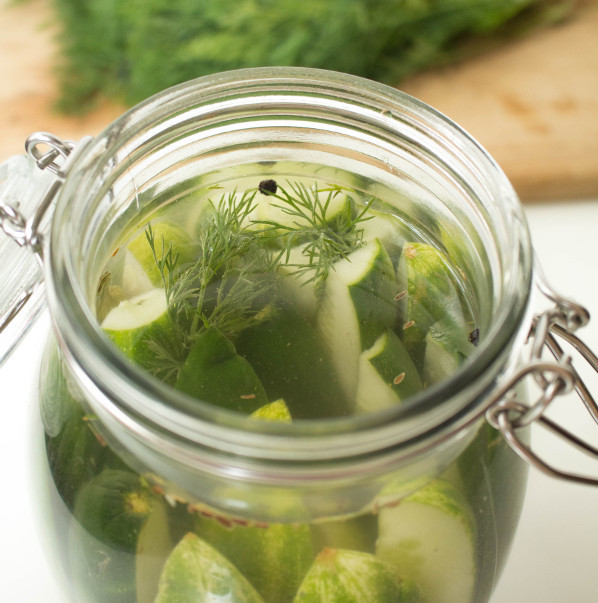
sauerkraut
Sauerkraut is one of the oldest traditional foods.
Made from fermented cabbage, it boosts digestive health, fights inflammation, strengthens bones, improves circulation, and reduces “bad” LDL cholesterol.
This homemade sauerkraut recipe is my favorite!
It contains caraway seeds, which gives it a nice, unique flavor that really takes it up a notch.
Homemade, fermented sauerkraut is one of the best recipes to start making your own fermented foods because it’s easy to make, crunchy, and delicious.
This recipe makes it even easier using a quart-sized mason jar instead of a special sauerkraut crock, so you don’t need any special equipment, and you won’t make loads of sauerkraut at once.
PRO TIP: Be sure to consume fermented sauerkraut raw at least most of the time to get all those healthy probiotic benefits.
Of course, you can heat this sauerkraut to make various dishes. It’ll be delicious, but the probiotics will have died off in the heat.

yogurt
Store bought yogurt often contains loads of unhealthy added sugar.
Control what goes in your yogurt – and your body – with this simple yogurt recipe that’ll also save you money over store bought.
This recipe even has instructions on how to strain the yogurt if you prefer thick and creamy Greek style yogurt.
Use organic, grass-fed milk – or even raw milk – for the best health benefits.
PRO TIP: If you’re lactose intolerant, you may be able to eat yogurt without ill effects because the fermentation process breaks down the lactose.
Kefir is another dairy product lactose intolerant people can usually enjoy – keep scrolling to learn about this delicious, gut healthy drink!
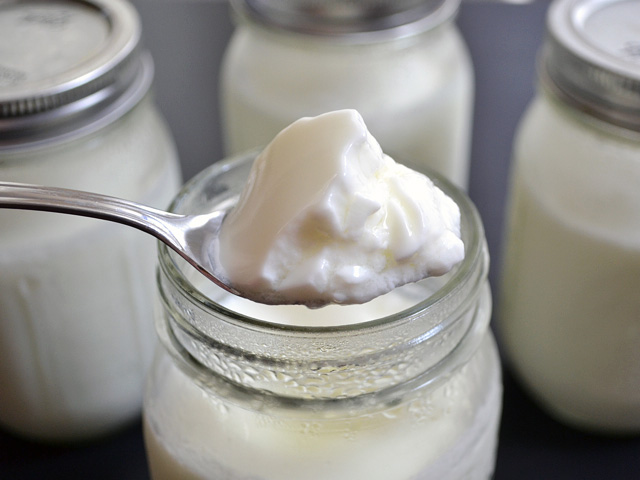
non-dairy yogurt
Trying to avoid dairy?
Check out this Coconut Milk Yogurt that uses probiotic capsules to activate the fermentation process and tastes far better than store brands!
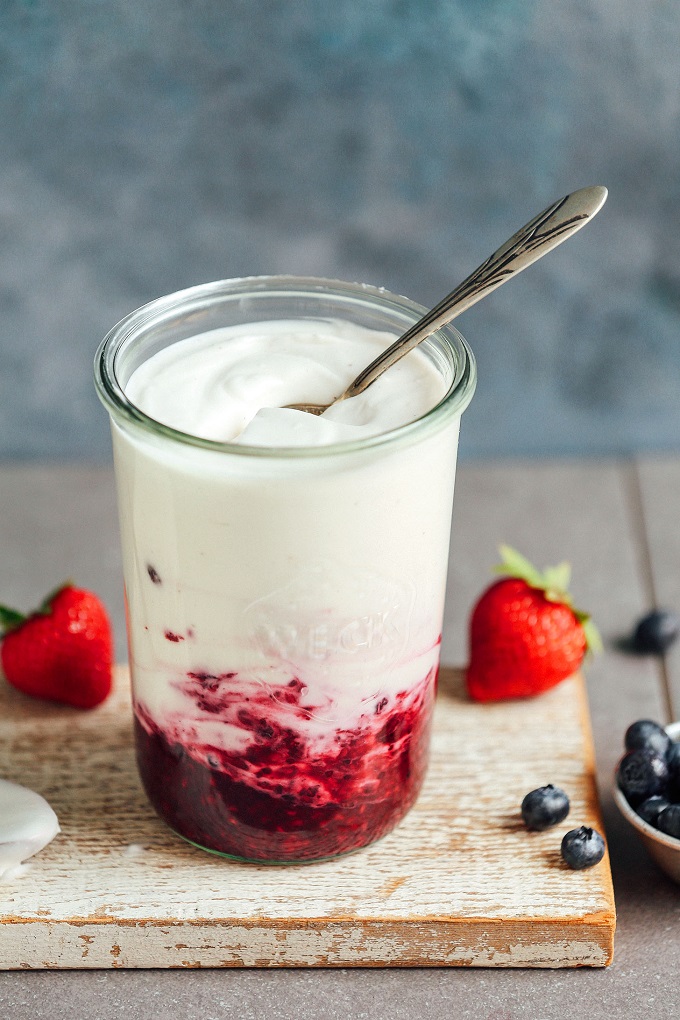
sourdough bread
With gluten-free diets, bread has been sort of demonized lately, so you may be surprised to see it on this list of healthiest probiotic superfoods.
Though sourdough contains similar amounts of calories, carbs, and fiber as white bread, it’s healthier because it’s also lower in sugar, higher in protein, and typically made with whole grain flour.
Just like the other fermented foods on this list, sourdough is fermented using lactobacillus cultures.
These cultures don’t survive baking, but the fermentation process produces lactic acid, which helps you absorb certain nutrients.
Sourdough also stays fresh after baking much longer than other breads and doesn’t require any extra preservatives, since those live yeast cultures preserve it naturally!
Sourdough is made by using a sourdough starter, which you can buy from a bakery, get from a friend, or make yourself.
Learn how to make a sourdough starter from scratch here. Want a little help making your starter?
Try the Cultures for Health Sourdough Starter Kit!
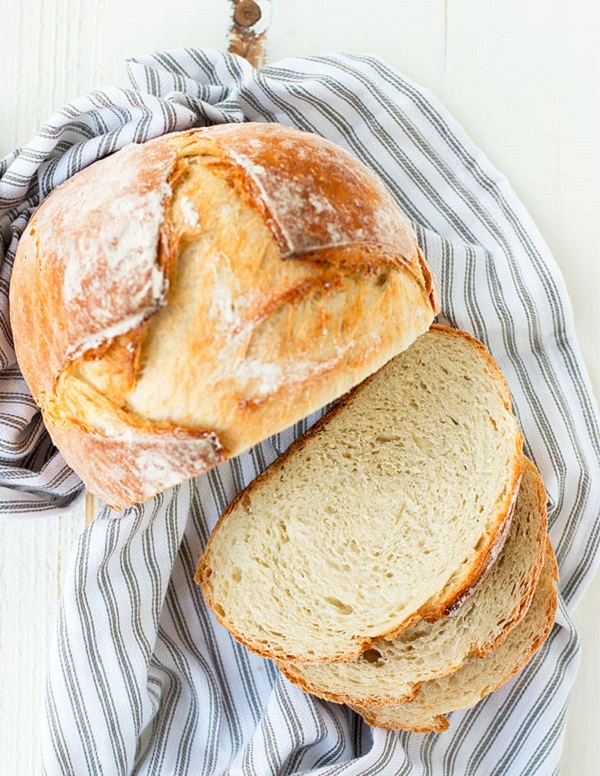
miso
Miso is created by fermenting soybeans, barley, or brown rice with koji bacteria.
Miso has anti-aging properties, helps maintain healthy skin, boosts the immune system, improves bone health, lowers the risk cancer, and promotes a healthy nervous system.
Since miso is fermented, it is also a good source of probiotics, but it’s also relatively high in salt, which can cause increased blood pressure in those with sodium-sensitive hypertension.
Miso is most often made with soybeans, which has been getting some negative press as of late because overconsumption can cause hormone imbalance, inflammation, and harm the thyroid gland.
However, fermentation breaks down the “anti-nutrients” in soy that can cause health problems, making fermented soy products like miso, tempeh, and natto (both also on this list) perfectly safe to consume in normal amounts.
Of course, it’s still a good idea to consume only organic, non-GMO soy and watch for hidden soy content in processed foods to avoid eating too much.
Making your own miso takes a long time – 6 months if you start in the spring or 10 months if you start it in the fall.
However, it’s not a difficult process by any means (pretty much set it and forget it), and homemade miso is much tastier than store bought, which makes the long process seriously worth it!
You can also buy miso in stores and on Amazon to add healthy flavor to soups, stir fries, salad dressings, meats, vegetables, and more.
PRO TIP: Especially if you’re new to miso, I recommend you try the white or yellow miso, since these kinds have a milder flavor than the red miso and can be used in a wide variety of dishes.
My favorite way to enjoy miso is in traditional miso soup because it’s healthy, warm, and comforting.
This 15-Minute Miso Soup with Greens and Tofu is a great dish to get you started with the classic Asian flavoring.
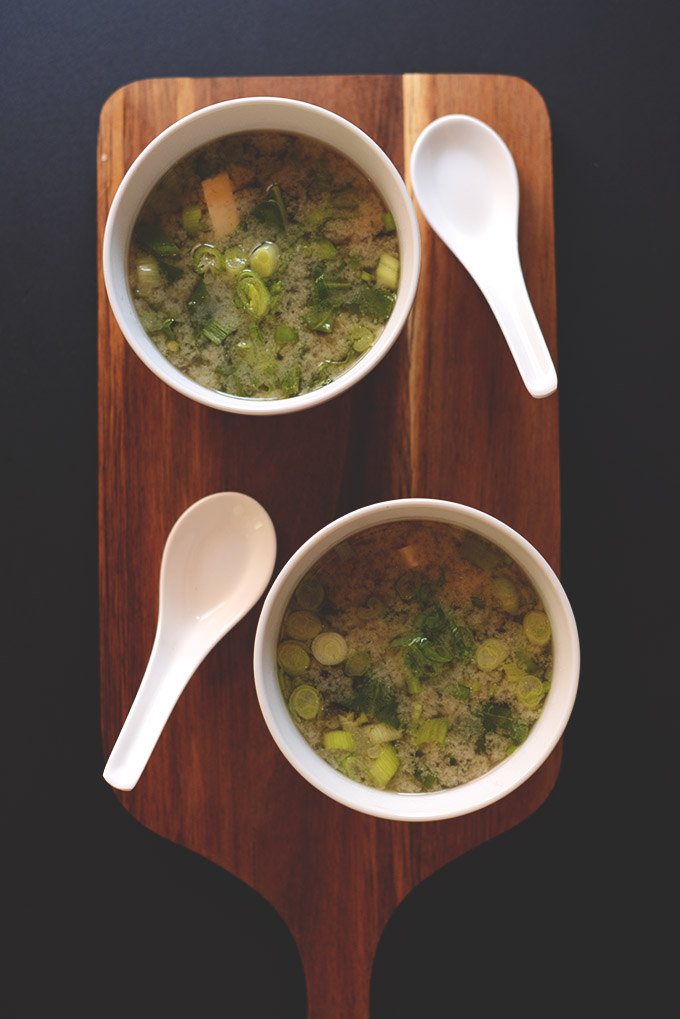
tempeh
Tempeh is another popular and beneficial fermented soy food that is made by adding a starter to soybeans, also called edamame, to form a cake-like product.
Tempeh has the same protein quality as meat, promotes muscle recovery, increases bone density, reduces cholesterol and menopausal symptoms, and also contains high amounts of B Vitamins.
You can buy tempeh in most grocery stores, or make your own with a Tempeh Starter Culture.
Tempeh can be used in a variety of dishes. Here’s a delicious tempeh bacon substitute you can enjoy on its own or in a fresh salad.
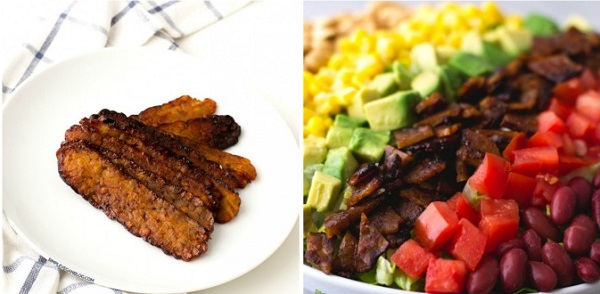
raw milk cheese
Raw milk cheeses are made with raw milk, or milk that hasn’t been pasteurized.
You may be wondering, “But isn’t that unsafe?!”
Actually, raw milk has many extraordinary health benefits from providing probiotics and other beneficial bacteria that can help strengthen your immune system and disease resistance to alleviating allergies, among other benefits.
You just have to make sure to buy your raw milk from someone you can trust to handle it in a safe and sanitary manner.
Still not convinced, or just want to learn more? Check out this website.
You’ve probably noticed that the milk you buy at the grocery store has been pasteurized (heated and sanitized) and homogenized (mixed together – raw milk automatically separates with the cream on top and milk on the bottom, so you have to shake it before you drink it).
These processes also kill the good bacteria, probiotics, and other ingredients that make raw milk so healthy. So where can you get raw milk?
I’m pretty lucky because I live in rural Pennsylvania near Amish farms that sell fresh raw milk.
If you live near the countryside, take a ride on some back roads, and look for signs advertising raw milk for sale.
You can also search for resources with this online Real Milk Finder.
Make your own Fromage Blanc, or raw, cultured, soft cheese, with this simple and delicious recipe made with milk, mesophilic culture, and liquid rennet.
This is a great recipe to start making your own cheese because it’s super easy and you can use the finished product on just about anything.
Use as a spread on breads, bagels, waffles, and more, melted on scrambled eggs, mixed with flavorings to make your own sweet and savory spreads, served with and in desserts – the possibilities really are almost endless!
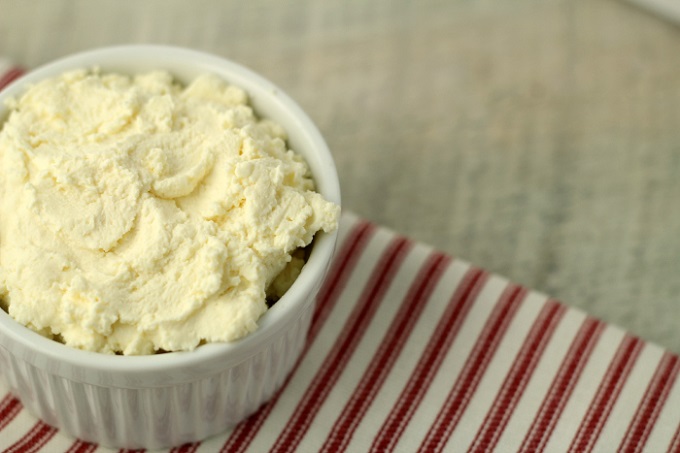
raw cultured cashew nut cheese
If you’ve never tasted dairy substitutes made with cashews, I highly recommend them and this recipe, which uses probiotic capsules to culture this completely plant based cheese.
This recipe shows how to use soaked cashews to make an unbelievable creamy and dairy like spreadable cheese even the pickiest eaters will enjoy!

vinegar
Apple cider vinegar (ACV) is an extremely popular health food right now.
ACV is made from apples, vinegar, and a bacterial culture, known as “the mother.”
ACV has numerous purported benefits including helping to alkalize the body, treating acid reflux, colds, and flus, and improving gut health with probiotics.
Many natural health professionals recommend taking ACV every day to promote health and wellness.
You can buy Bragg’s Apple Cider Vinegar at just about any grocery or health food store.
This type of ACV is exactly what you want because it’s unpasteurized and still contains “the mother,” which holds all the health benefits.
You can also make your own with this recipe here.
While apple cider vinegar is really healthy, you might find the taste a bit strong.
If this is the case, check out this Homemade Vinegar Recipe made with fruit (link below).
It contains some ACV – and, therefore, all the benefits – with a much more pleasant taste.
Plus, this vinegar is fermented, so it still contains plenty of those super healthy probiotics.
PRO TIP: Some people recommend taking ACV as a shot, but I don’t agree with this idea at all.
Vinegar is very acidic, and when you drink it straight, it can weaken and remove tooth enamel or erode your esophagus, potentially causing serious health problems!
To enjoy ACV and other vinegars safely, make sure you never consume it without diluting it first – mix vinegars in salad dressings, with water and other drinks, etc.
I drink a tablespoon of ACV mixed in a big mug of water and sweetened with honey to treat acid reflux and get the other health benefits ACV provides without the damage.
Also, be sure not to brush your teeth for an hour after consuming acidic foods, so your enamel can harden first.
If you brush directly after eating or drinking acidic foods, you may brush away your enamel!

kimchi
Kimchi is a traditional Korean side dish made from salted and fermented vegetables.
The most common ingredients include napa cabbage, green onions, and daikon radishes (available in many grocery stores), with spices and seasonings like chili powder, garlic, ginger, and jeotgal (salted seafood). Authentic kimchi gets its umami taste from fish or fish sauce, though there are some tasty vegan versions, as well.
Kimchi is a low-calorie, whole food that is great for weight loss.
It is also known to improve cardiovascular and digestive health and contains high levels of antioxidants that reduce the risk of serious health conditions, including cancer, diabetes, obesity, and gastric ulcers.
Kimchi is almost always served as a side dish in most Korean family households and restaurants and can be eaten alone, with white rice, or mixed in other traditional recipes like porridges, soups, stir fries, dumplings, fried rice, rice cakes, and more.
You can buy kimchi in most supermarkets – it’s been pretty popular in the states for the last several years – or you can make your own with the authentic recipe via the link below.
Prefer a plant based version? Check out this vegan kimchi recipe.
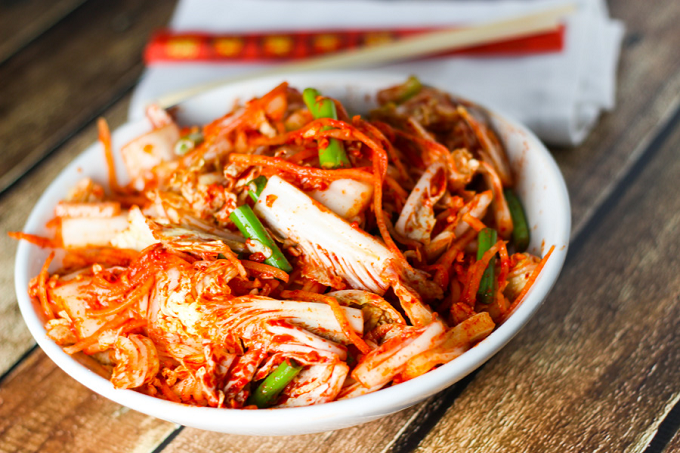
natto
Natto is a fermented soybean dish that is especially healthy because it contains Bacillus subtilis, which is an extremely powerful probiotic that has been proven to support the immune system and cardiovascular health and aids the digestion of Vitamin K2.
This Japanese superfood is actually the best food source of Vitamin K2 and also contains a powerful anti-inflammatory enzyme called nattokinase that has been proven to fight cancer.
Natto is so good for you its nutrients are even offered in supplement form.
You may be able to find natto in some grocery stores and health food stores, but homemade tastes better, of course. You’ll need natto starter and a pressure cooker – I really like the Instant Pot – but the process is easy and pretty quick at around two days.
Natto is traditionally served as a breakfast food in Japan with rice, spicy mustard, soy sauce, and raw egg, but you can also eat it with other grains, condiments, greens – whatever you like.
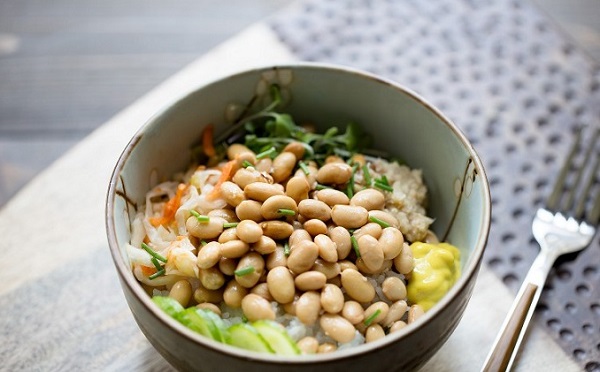
With increased availability of processed foods and junk foods, keeping your gut and your body healthy is more difficult than ever before!
Eating plenty of the Probiotic Superfoods on this list will help you heal your gut, increase your immunity, and may even help you lose weight!
What do you think of these 10 Best Probiotic Superfoods? Please share your thoughts in the comments below!
related posts:
10 Delicious, Gut Healing Probiotic Drinks You Can Make at Home
14 Incredible Overnight Oats Perfect for Busy Mornings
20 Easy Ways to Boost Your Metabolism [That are Backed by Science]
30 Best Weight Loss Foods You Need to Keep in Your Kitchen
30 Easy Ways to Eat Healthy on a Budget
pin for later:

March 5, 2021
by
Sarah
Join the Community
Subscribe now.
Want insider tips, latest trends, special offers, and a dash of magic ✨ in your inbox?
Copyright 2017-2025 • Sarah Blooms • Design By Piperlane
Copyright 2017-2025 • sarah Blooms
Design By Piperlane • Privacy Policy
View the Comments
Add a Comment
Comments will load here